#some of them are fun but the majority are just visual/audio effects with zero gameplay design
Text
"kinda reminds me of shitty mario maker levels, but with a little more flair."
–Aurateur, on Wonder Flower segments
#aurateur#he's so right though#some of them are fun but the majority are just visual/audio effects with zero gameplay design#wonder is the textbook definition of style over substance.... which is a shame because the style is excellent#it is fun.... but not $60 fun#it feels like a dsiware game with fancy graphics#I'll say it again - modelers and animators working overtime doesnt make up for designers and developers who take it easy
2 notes
·
View notes
Text
Title Teleportals Developer PixelGreeds Publisher PixelGreeds Original Release Date June 15th, 2018 Genre Platformer Platform PC Age Rating Unpatched: Mature
Patched: 18+
After having played Maytroid and giving it an average score, I decided to review another game by PixelGreeds to see if I would have a similar experience. When it comes to developers that are new to me, I do try to play more than one game by them if available, especially if it proves a group has a wider range, style, and a greater skill set than what a single game can convey. And so, I decided to give an earlier game by PixelGreeds a chance. Teleportals, as one could guess, is named after Portal, yet, similar to Maytroid’s naming, is not quite the carbon copy one should expect going in.
Teleportals is a puzzle-platformer in which you control a woman named Susan, who randomly arrives in an alternate realm. How she got there or why remains a mystery. She soon finds a companion in a one-eyed ball-like creature named Maki, who tells her that time spent in this realm will have an adverse effect on her. The only way to prevent her eventual demise is to escape. The single upside in all of this is that she can teleport to where Maki is dropped. With not much choice, Susan takes Maki with her and begins making her way through this realm in hopes of finding an exit.
The overarching plot of Teleportals is painfully straightforward with escape as a driving force. Susan arrives, wants to leave, and so she goes on her way. As to where she is, how she got there, who these things are that she meets, and how she can teleport with them, none of this is explained. It just is, and we’re meant to take it at face value. Setting all of these questions aside, there is another narrative that takes place, which does a far better job of providing a much needed story element, as well as adding character development. For one, Susan has a backstory, in that she is a scientist researching a virus. Due to her lab running out of funding, one of her colleagues, Nancy, infects herself with said virus in an attempt to garner funding and push the research forward. Susan’s thoughts often return to Nancy, a means for Susan to strive ever closer to escape.
Maki also provides narrative strength, discussing his interest in movies, which serve as his attempts to have Susan open up during their campaign. There are several moments of humor and charm here and they contrast in a particularly satisfying way with Susan’s concern for Nancy and her drive to return and finish her work. We even see Susan forget her troubles at times, hinting at a desire to run away from an anxiety that potentially runs deeper than first implied. In fact, the narrative even suggests that there is more to the situation of Nancy infecting herself than Susan lets on. These glimmers of story are helpful to a weak plot and I would have liked far more than what is delivered.
Why do I say “far more?” Because glimmers of a story do not make an intriguing, immersive experience. More than anything, I felt dissatisfied, as I was left confused, maybe even a little cheated when I finished the game. All we actually get are hints at an underlying conflict that goes beyond the text we are given. The text itself, which I believe is a translation from another language, is not nearly strong enough to make the implications it’s attempting to make. Also, there is no proper resolution to the story at the end. We are left wondering what happened, why, and again, what significance it’s trying to imply. After one ending and credit roll, there are more levels and then a vague epilogue as if those last levels didn’t happen. What was even the point? More mystery? No, just more random nonsense. Zero genuine conclusions can be made with such a fierce lack of details.
The developers want to insinuate that there’s more happening in the plot, but without proper set up and build, it comes off as a collection of fragmented ideas that, again, seem nonsensical. If you’re planning to develop a deep lore, you need details. Vague is not the same as mysterious, nor does it build mystery. Now, there are theories floating around on the game’s Steam discussion board that could potentially make sense and better connect these fragments into a coherent story. However, I believe these theories are simply too far-fetched. Huge stretches need to be made and some major assumptions are necessary for these theories to work. Granted, you can theorize until you’re blue in the face with such a lack of detail and depth. A stronger overarching plot and a far more detailed look into these characters would have turned a forgettable mess of a story into one of legitimate intrigue.
Although Teleportals suffers from this lack of story, a recurring problem I’ve seen from them, its gameplay fares better. As I mentioned, this is a puzzle-platformer, in which the goal is to reach each room’s exit. Every single room is its own puzzle filled with traps for you to avoid and designs that require the unique attributes of your companions. Susan has the ability to swap places with Maki and another character, Bruce, who you meet later on. Susan can run and jump, as well as activate switches. Maki is small and light, allowing him to pass through narrow spaces and also bounce on special platforms when dropped. This bouncing can allow Susan to swap and reach higher areas or launch over hazards. Also, if there is a jump too high for Susan, she can place a companion near the jump point, bounce herself, swap, and ride the momentum for a higher jump. As for Bruce, he is a block-shaped entity that can act as a shield against projectiles or a step for higher platforms. Many of the later rooms will require you to utilize both companions, using their attributes and working them in tandem to reach the exit. Once you start playing, it may seem like gameplay is one-dimensional, but I was easily engaged throughout. There were several puzzles that caused some frustration, but I will admit that it was always pretty satisfying to solve these more troublesome rooms, especially the ones that take you multiple tries.
Other gameplay points include zero penalties for dying and a quick reset button for starting a room over. For the most part, the game is pretty fun and it challenges you thoroughly, however some puzzles have quite a few obnoxious elements to them. Even so, with no consequences to infinite attempts, every puzzle is doable with practice. Also, there is no combat in this game. While there is a means for Susan to destroy certain traps, there are no real enemies to fight. It’s simply surviving each room and exiting, yet the simplicity offers a lot more fun than I could have expected. Finally, gameplay options include support for multiple languages. I can appreciate the wider audience multiple languages can garner, but I’m still wondering if some things got lost in the translation.
My only complaint with Teleportals’ gameplay is in regards to its controls. I had the same complaint previously with PixelGreeds, in that if you wish to use a controller, you must rely on third-party software for any customization. Teleportals requires precision in your moves, so having zero controller customization out of the box is disheartening. Keyboard controls have customization, but if you wish to make changes, you must input all of your changes anew, as you cannot simply change a single key binding.
Moving on to the aesthetics, I had much to say about several of the visual additions seen in Maytroid that basically took a game that could have been for all ages into mature and 18+ territories. This seems to be PixelGreeds’ style, as an ecchi CG gallery that can become fully 18+ with a patch is present here. And, as in my Maytroid review, this inclusion does nothing for Teleportals. It’s senseless, as it limits the potential audience that can play this game. Perhaps my opinion is an unpopular one, but not everything needs naked women to make it better. Putting that time and effort towards the plot would have made more sense. Or, if you want hentai in your game, make it the focus of the game and don’t just tack it on. Having said that, the artists responsible for these CGs do seem to have a bit of talent. I only wish those talents were utilized in the form of in-game CGs to support dialogue or other on-screen events.
As for the in-game presentation, the aesthetics are satisfactory with its 16-bit visual style. Even though this game uses the same tilesets and backgrounds as Maytroid, they are no less impressive. Several different environments are depicted, from dusty deserts to snow-covered forests. It’s hinted that these environments even symbolize the symptoms of the virus Susan is researching. For example, one of the early symptoms is coughing or a sore throat. She makes this comment while in an arid desert, which is an early game area. A later symptom is a high fever and the connection is Susan commenting that she doesn’t feel cold, despite walking around wearing only a nightie while traveling through a snowstorm. As this narrative takes place later in the game, it points to the later stage symptoms of the disease.
Unfortunately, these connections to location, time, and viral symptoms all amount to speculation, theorizing, and tidbits the developers mention on Steam, as none of this is ever directly addressed in-game. A stronger symbolism or one with more direct connections would have made more impact. I realize this is another criticism of narrative, not aesthetics, but give me a strong, fleshed out story first, and then pepper it with secrets using the other facets of the game. Having said that, the storytelling flaws don’t take away from the quality of the visuals themselves. Finally, the audio is fair, with each track pairing to their locations adequately. My complaints are that the music itself isn’t all that memorable and there is too little of it. I think I counted just four or five tracks in the entire game. Also, these tracks may actually be the same ones used in Maytroid, but again, unmemorable.
Teleportals as a whole is a collection of great gameplay elements beaten down by unfinished ideas and bad decisions. If you were to strip away the plot and the lewdness, then the gameplay by itself would most definitely serve as a fantastic base for a potentially great game. I would even say by expanding gameplay further and properly addressing the plot, this would have had the makings of a hidden gem. The game can be completed in a single sitting, clocking in between three to five hours. Perhaps its saving grace, Teleportals can be picked up for $1, even less during a sale. So, if you’re in the mood for some quick platforming fun, and not a darn thing more, then maybe Teleportals is worth your consideration.
This slideshow requires JavaScript.
[easyreview cat1title=”Overall” cat1detail=”” cat1rating=”2.5″]
Review copy provided by developer.
TBT REVIEW: Teleportals Title Teleportals Developer PixelGreeds Publisher PixelGreeds Original Release Date June 15th, 2018 Genre Platformer Platform PC…
1 note
·
View note
Text
Horizon Zero Dawn (2017)

Horizon Zero Dawn is a game that came out of nowhere for me. Guerilla Games’ track record is a bit suspect at best, and the fact that Killzone Shadow Fall was, to be kind, a forgettable experience so there wasn’t really any reason to have any expectations for their latest offering.
Yet somehow, despite the complete shift in genre, Guerilla has managed to deliver a game that is fun to play and features an engaging world to contextualize that play. The core mechanic in the game, fighting against the robotic creatures in the game, fulfills the promise of an open-world combat system. As Aloy, you have many options at your disposal to engage with these monsters. You might stalk them in the grass and strike from behind, or you might choose to set up various traps along their patrol paths, or perhaps you might go in guns blazing (or bows blazing) and shower them with arrows.
The actual mission design leaves a lot to be desired — the majority of the missions in the game have the same loop: find a quest giver, go to a waypoint on the map, follow a glowing purple trail, fight some enemy, return home to collect your reward — but the combat more than makes up for the cliched gameplay loop.
What surprised me the most is that the game itself is built in a way that should offend me, in the same way that Ready Player One and the news of a Matrix reboot lead me to believe that popular culture is dying a slow death, regurgitating both the gameplay mechanics and science fiction tropes that can be found in many other properties.
As a game, it obviously draws inspiration from the many Ubisoft games that have driven the open world formula to the ground, with towers (of a sort) to climb and a map riddled with icons displaying a myriad of collectables. As a fictional world, the future depicted in Horizon is a pastiche of science fiction ideas pulled from a myriad of sources — Earth is doomed because Ted Faro, a billionaire with an overinflated sense of self-importance, designed military robots that consumed organic matter for fuel, thus dooming all of humanity. Realizing that there was no way to stop the robot apocalypse, humanity, led by Elisabet Sobeck, developed a plan that would save life on Earth — wait for the machines to wipe out all life on the planet, then “reboot” everything by reintroducing humanity once the machines have died off and the planet is safe. There’s even a ship full of embryos being sent into deep space as a backup plan that you can read about in the audio logs, so you can check that box too.
But that’s fine. Sure, the game feels like Assassin’s Creed with Terminator slapped on top of it, but it’s a text that proves that something really can be greater than the sum of its parts. The game unapologetically draws inspiration from a variety of video games and science fiction texts, but is never bogged down by its source material. It’s neither referential nor reverential to the material that it is drawing from, so you never feel taken out of the text because a writer/designer wants to show you how clever they are by trying to point out something you should immediately recognize. No one says something stupid like “Come with me if you want to live” just because Horizon is a game about a robot uprising.
Having played a bit of Ghost Recon Wildlands, a game that faithfully follows the Ubisoft open-world formula, you can immediately see the difference between a group of designers who care about creating a compelling lore for their world and a group where the lore is essentially just window dressing for the gameplay loop. Even after a week finishing Horizon, I still find myself speculating and thinking about the “post” post-apocalyptic world that Guerrilla has created.
There is one criticism I have with the game that I wanted to talk about. For the most part, I’m content with how the story and lore is delivered to the player. There’s nothing really unique here in terms of how the narrative is presented to the player — you have standard cinematic cutscenes, audio logs, text logs, “in game” cutscenes (which are essentially audio logs with character models that you can look at), and conversations with NPCs. There’s a token attempt to give the player some choice by allowing Aloy to choose how to respond to certain situations (although I can’t remember the in-game terms, essentially she can be sympathetic, cruel, or thoughtful), but these decisions are essentially inconsequential.
I suppose that’s fine. I understand that most of the resources are going to be devoted to creating an open world that is worth exploring since that’s going to be how you spend most of your time with the game (and it’s clear that the designers are enamored with their work because they included a “photo mode” for you to take screenshots and show off their work for them), but I can’t help but be somewhat disappointed by how the story is delivered.
In particular, the NPC conversation system is ripped straight out of a BioWare game… from 10 years ago. Here’s how a typical conversation plays out in the game:
youtube
Forgiving the fact that the facial animation feels off, particularly Aloy’s smile at the end, doesn’t this conversation feel very familiar if you’ve played any BioWare game made in the last 15 years or so? It’s two people standing, always facing each other, while the camera simply cuts between the two of them. Shot/reverse-shot, over and over again. Every single conversation looks exactly the same, even important ones where some major plot point is being revealed to Aloy/the player.
Even the first Mass Effect tried to break up its conversations with some more interesting camera angles:
youtube
I don’t think I’m being unreasonable in believing that a game released in 2017 should at least have better presentation than a game released in 2007. Particularly if I’m forgiving the developers for not really introducing any ludic storytelling moments in their game at all.
I wanted to illustrate how distracting this presentational style can be with an explicit example, so I’ll just say now that the rest of this discussion will contain spoilers for the end of the game.
At the beginning of the game, you start off playing as a younger version of Aloy who is being trained by Rost, her adoptive father figure, in the ways of the Nora. Through a various set of circumstances, Rost eventually sacrifices his life to save yours, fulfilling his duty as a father-figure who must die in order to motivate the main character (as I said, the game is not really original, but in this context it sells the story).
One of the bigger mysteries in the game is Rost’s relationship with Aloy — why was Rost ostracized from his society? Why does he care so much about Aloy?His character also introduces questions about Aloy’s character as well — who are Aloy’s parents? These questions help make the quest to save the world from another robot apocalypse much more interesting, because suddenly Aloy has personal stakes in the quest which makes her immediately relatable to the player. The game is as much about discovering the truth about Aloy’s “family” as it is about trying to stop the rogue AI Hades and his plans to consume the world.
You have an engaging world that you want to explore and an interesting main character that you are learning about as you play the game. You and Aloy learn her identity at the same time (although the game gives you ample opportunity to guess at her true identity throughout the game), and the revelation that Aloy is a clone of the original Elisabet Sobeck, the woman who tried to save humanity during the original apocalypse, lets you connect to both Aloy’s devastating realization that she was bred for a specific purpose and to the overall narrative of the game.
That’s all great, and it pays off in a wonderfully emotional moment for Aloy at the end of the game. Yes, she never had parents, but she had a father-figure who taught her the skills to survive in the new world and a mother-figure who guided her on her journey to save humanity.
But let’s look at how the game presents this characterization to the player. Here’s how Aloy’s relationship with Rost culminates in the game:
youtube
After his noble sacrifice, he is eventually buried next to his home, and Aloy can visit his grave to update him on her journey. Speaking to a loved one’s grave is a ritual that everyone can relate to , and we’re meant to feel for Aloy’s loss by getting a glimpse at how much she still cares for him. Except this sentiment is ruined by the game’s archaic conversation system. It’s clear that the game is treating Rost’s grave as a second “character” in this conversation, and because of how limited the conversation engine seems to be, the only thing the developers were able to show is the back of Aloy’s head while she speaks to a badly framed shot of the grave. We don’t even get a cut to a reverse-shot of Aloy speaking so that we might be able to see the emotion on her face as she pours her heart out to her father. The best they can do is switch to a medium shot so that the visuals aren’t entirely static, but it’s hard not to see the limitations of the game engine. Certainly it robs the moment of its emotional impact because you can’t help but notice the static nature of the scene.
Now let’s take a look at how they present Aloy’s search for her “mother’s” grave:
youtube
The difference is night at day. Yes, it’s a cutscene, and so they have a lot more control over what they can show. It’s much more crafted, and honestly, more cinematic than the scene where she speaks to Rost. We get shots of both Elisabet’s body and Aloy’s reaction to finding her mother. We even get the crane shot at the end to show us not only that Aloy has discovered who she is, but that both Elisabet and Aloy have managed to save humanity from destruction.
Now, do I wish there were more cutscenes in the game? Of course not. The last thing I want is another Uncharted where the game’s story is conveyed through unskippable non-interactive cinematics. But they could have done something to at the very least spice up the NPC conversation system to do more than just show the two characters talking to each other. There’s no reason why Aloy couldn’t have been talking to Rost’s grave while clearing some brush away from the stones, or even sitting down next to it while facing the camera so that we could see her character emote. The same goes for every single conversation that you have in the game, from the relatively minor ones like the one above with Talanah, to the major ones where you speak with Sylens about the true nature of the Zero Dawn project.
Horizon Zero Dawn is a game that, outside of its combat mechanics, doesn’t try to reinvent the wheel. It’s an experience that feels very familiar, both in terms of the gameplay loop and in terms of the story it conveys. But if you’re willing to forgive the well-worn nature of the game, and in my case, the issues with how the game presents its story, then you’ll have one of the more fulfilling game experiences of the year.
2 notes
·
View notes
Text
Horizon: Zero Dawn - A Review
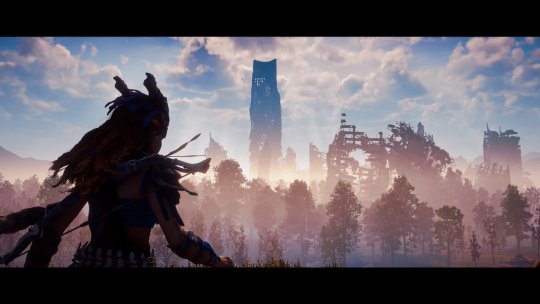
Right, gimme a moment to compose myself after the INCREDIBLE RIDE that was this fucking game.
Okay. So. Picture it: E3 2015. There I was, minding my own business, completely PS4-less and only scoping out upcoming PC titles since at the time I was a proud PC gamer. Deep down I was always bitter that I probably would never get a PS4, though, so I usually knowingly avoided any footage of PS4 games like inFamous: Second Son, Uncharted 4, etc. I’ve always been a naturally jealous person, so seeing footage from those games at the time sorta stirred up some jealousy there.
But regardless of that, I still end up seeing the original gameplay trailer anyways. And holy fuckballs, I was so pissed. There in front of me was footage of a game that was literally MADE for me, I swear to god. It had all the elements that I loved in a game. Let’s list them, shall we?
Lush open world with gorgeous vibrant landscapes and incredible graphics: check and check
Female protagonist that looks badass and is voiced by ASHLY FUCKING BURCH: check, check and check
Bow and arrow combat: check
Stealth: check
RPG elements like side quests, skill trees, dialogue trees, etc: checkcheckcheckcheck
Intriguing and mysterious story: check
Platforming and climbing mechanics a la Tomb Raider & Uncharted: check
Honestly, I could go on and on but you get the idea. I never thought I’d see the day where a game could so perfectly fit the criteria of everything I like. So 2-Years-Ago-Me was completely heartbroken since at the time I was convinced that I’d never own a PS4. It was up there with Kingdom Hearts III as the games I thought I’d never get to experience.
Flash forward to now, having been a PS4 owner for about several months. This game was pretty much top priority on what to get, so as soon as it was available for preorder, I clicked that shit so fast I almost broke my mouse. So naturally, when the game finally became playable, I completely immersed myself in it.
This may be a bold statement, but I think Horizon is going to be one of my favorite games of all time. For real.
So all those elements I listed up there were true, but there were also additional elements I love that I had no clue were even in it, prior to playing. Like for example, I had no idea just how deep into the RPG category it was going to go. This game was so freaking immersive. I was immediately in Aloy’s shoes and experienced the world through her eyes, starting from childhood. And then what a pleasant surprise it was when I discovered that the game presents you with moral choices, too! At that moment I knew that the game was going to exceed my already extremely high expectations.
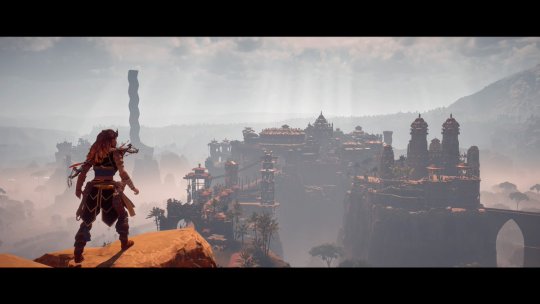
There are also dialogue trees in which you can exhaust a lot of dialogue from, and I of course took every chance I got to choose all the options. I thoroughly enjoyed learning more about this intricate world Guerrilla Games has built and encountering its inhabitants. I loved finding out more about all the different tribes and their own unique traditions and religious beliefs, as well as their relationships with each other. It also helps that their outfits are all so fucking rad. In addition to all that, there are collectibles called “datapoints” where you could find various text, audio and holographic documents from the world of the “ancient ones”, and there’s so many interesting tidbits you can discover from these files. Guerrilla really has fleshed out this world as fully as they could. And let’s quickly touch on the diversity this game has. Man oh man, there were so many people of all different races throughout this game. Lots of strong female characters who weren’t one-dimensional, and I even stumbled upon a gay character during one of the side quests. The diversity showcased doesn’t feel contrived or there to appease the masses, it feels natural and well represented.
I was a bit worried about the story at first, since Guerrilla were definitely shrouding it in mystery and being extra vague every chance they got, which I guess a part of me did like, since it made me not know what to expect and heightened my sense of discovery while playing. But these devs have crafted a really amazing story with a likable cast of characters, including the star of the show Aloy herself. I’m a little biased about her though, since she’s voiced by Ashly Burch who I adore to pieces, but even regardless of that she was simply a wonderfully written character. I just loved watching the story unfold, finding out more and more about what happened to the world and witnessing Aloy finding out the truth about who she really is. The lowest expectation I had initially about this game was probably the story, but it didn’t disappoint at all. I was thoroughly hooked and craved to know more. I won’t spoil anything, since I want those of you who are going to play the game to be more engrossed by it as you have your own experience through it.
Those of you who have seen screenshots and/or gameplay know that this game is a visual masterpiece. The environments are lush and full of life despite the post-apocalyptic nature of it. Originally I had thought the Last of Us had the most gorgeous post-apoc landscapes of all time, but Horizon definitely takes the cake for this one, no question about it. There’s a photo mode available, and because the game itself is so beautiful, it’s probably impossible to take a bad shot. Even without using the filters provided, the graphics have that gorgeous pinkish glow that I always love in games, very reminiscent of Dragon Age: Inquisition I think. The screenshots in this review were some snaps I took using the photo mode feature, and it’s really fun to play around with. You could probably spend hours with it taking scenic shots and action shots to your heart’s content.
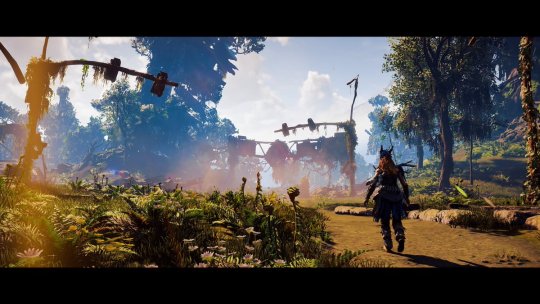
Now let’s talk combat. A game automatically has me sold when it has archery. My love of this developed through the 2013 Tomb Raider remake, which I’m sure I reviewed on here a long while back. It grew when I played the sequel to that remake, Rise of the Tomb Raider. This game takes that style of combat and amps it up to a hundred, adding a bunch of various unique and craftable arrow types, as well as multitudes of elemental traps and explosives. Most unique out of these is probably the Ropecaster, which allows you to tie down enemies to leave them immobilized. These are extremely useful for the flying machines that you’ll encounter later on in the game, since they can be pretty tricky. The combat relies heavily on weakpoint takedowns, so you’ve definitely gotta have real good aim in order to slay them robots, especially the bigger ones. Unlike most action games, you can’t just go in guns blazing and continuously shoot arrows at random spots on the machines’ bodies. Focusing on their weakpoints is key, as that’s where all the real damage lies. Most of the robots are also weak to specific element types, so exposing those weaknesses gives you an even bigger advantage. Some enemies you could even strip off their ranged weapons and use it against them, which I thought was fucking radical. I did it more than a few times and it was a hell of a lot of fun.
There’s also melee combat in this game, although I rarely ever used it to be quite honest. The only use I found for melee are the silent takedowns during stealth, but in battle I would say ranged is the way to go. Battles with the machines are very exhilarating and intense, since they are clearly much more stronger than you, even the weaker ones. There are also human enemies like bandits and cultists, but they’re pretty easy to pick off since all it takes are headshots, basically. The machines are the real challenge. I played on Easy since I’m a scrub, and have always had no shame in playing games on easy difficulties anyways since, unlike most gamers, I’m not much of a fan of challenge. Basically for me, Easy is my Normal. That’s just how I roll. But even easy mode was a bit of a challenge at times, at least for me. I had some trouble with the huge, stronger machines. Then again, I pretty much spent the entirety of the game doing nothing but side stuff and power-leveling, so by the last few main quests I was already at max level. But even at max level and wearing arguably the best outfit in the game, the final boss was a lot to handle.
I’ve spent the majority of this review gushing about this game, but was there anything I disliked? In all honesty, not really all that much. Most of my negatives are pretty much small nitpicks. I thought the climbing mechanics could’ve been a little bit better, since unlike Tomb Raider or Uncharted, most of the platforming can be done just by pushing the left stick and only pressing the jump button once in a while. I would’ve liked it better if the jump button was more frequently used during platforming, basically. You also can’t filter between icons on the map, and the map interface can get pretty hectic as a result since there’s so much stuff cluttered in it. Not sure why they didn’t add the option to filter between machine sites, collectibles, etc. Would’ve made for an easier time navigating.
Another negative is probably how I wish the outfits were more customizable. As it stands, each outfit is already one full set, and the only modifications you can make are by using two or three slots where you can insert mods to increase certain effects like elemental resistances, stealth, etc. I wish it was a little more in-depth in that you could get different pieces for each body part, like most RPGs, and maybe be able to insert modifications to each individual armor piece. Actually, the modification system in general, for both outfits and weapons, is a bit too simplified for my taste. You can’t really upgrade them, it’s as simple as just inserting a mod or two and you’re done. This may be ideal for more action-oriented players, but since I’m an RPG enthusiast, I find it to leave much to be desired. There are some other small nitpicks I have with the game that hold it back from being absolute perfection, but honestly they’re all pretty much easy to ignore. The positives crush the negatives.

So yeah, overall I’m extremely overjoyed with how this game turned out. It’s everything I had been hoping for and then some. It literally just came out a few days ago and already I’m aching for a story DLC or, hell, even a sequel. This game better branch out into a franchise; there’s so much Guerrilla can explore with this world that they’ve created.
I give Horizon a 9.75/10. 9.5 seemed a little too low and 10 seemed a little bit too high, so I thought fuck it, 9.75 it is. This game is near perfection, and if you have a PS4 or are going to own a PS4 in the future, then I swear to you that you won’t regret having Horizon in your game library. It’s a mishmash of various elements in open world, action-RPG gaming all rolled into an impeccable, beautiful package. And for all you trophy hunters out there, it’s pretty easy to platinum too.
Man, do I love this game. Jesus. Looks like I’ve found something new to unhealthily obsess over.
0 notes
Text
Game of the Year 2017
You’ve likely heard it everywhere, but 2017 sure was a fantastic year for video games. Nintendo released their latest system, Microsoft put their upgraded revision of their console out on the market, and an Early Access title took the world by storm. All while this was happening, fantastic games were coming out at an unprecedented pace. Three of the games in my top 10 last came out within 10 days of each other early in the year, and two others came out on the same exact day later in the year. There’s something to be said about years ending in 7 having good games, and this decade provided yet another stellar showing.
This was a year where almost the entirety of the top 10 could have ranked even higher in previous years. That’s how good games were this year. I also spent a lot of time ordering my top 3 when I put this together last weekend, as the line is so razor thin that any of them could have won it. The end moral: what a year for games.
As always, the rules for inclusion are as follows:
The game must have its final retail release in 2017. Thus, anything in an alpha/beta state or Steam Early Access does not qualify. Based on the way games are being developed, this will likely be the last year this rule is in place.
In the case of episodic games, they must have their final episode delivered in 2017 to make the list.
While this list is comprehensive, I haven’t played everything. Games like A Night in the Woods, Hollow Knight, What Remains of Edith Finch, and Divinity: Original Sin 2 all seem great but are unfortunately all still on my backlog.
Most importantly: the game has to be really good. No-brainer there.
Honorable mentions:
This was the hardest year yet to limit the list to ten games, but here are the last five cuts I made:
Destiny 2 - Bungie managed to take the positive momentum of the later years of the original Destiny to make a great experience in Destiny 2, but there are definitely still some aspects to be cleaned up.
Sonic Mania - It’s the first truly great Sonic game in decades as Christian Whitehead nailed the essence of the Genesis-era games.
Persona 5 - A fantastic entry in the series that provides another strong cast of characters, stellar RPG gameplay, and a wonderful soundtrack.
Nioh - While often labeled a Souls-clone, the mission based structure and smart take on combat stances make this a unique experience.
Hellblade: Senua’s Sacrifice - This is definitely an important title for exploring mental health, and the true shining star here is the audio design. Definitely play this with headphones.
And now, here are my top 10 games of 2017:
10. Typeshift (Zach Gage - Mobile)

While many successful games this year focused on large, sweeping adventures, the one game I found myself launching daily was this clever word game. TypeShift gives you a simple task: shift columns of letters vertically to make words until you’ve used every letter at least once. While this sounds simple at first, the variety of different modes, including crossword-style clue challenges, help keep you coming back for puzzle after puzzle. There’s also a free daily puzzle every day, so the replayability is infinite here. This is the type of game that will stay installed on my phone for a long time to come, as it’s not something I see myself tiring of anytime soon.
9. The Sexy Brutale (Tequila Works - PC, PS4, XBO)
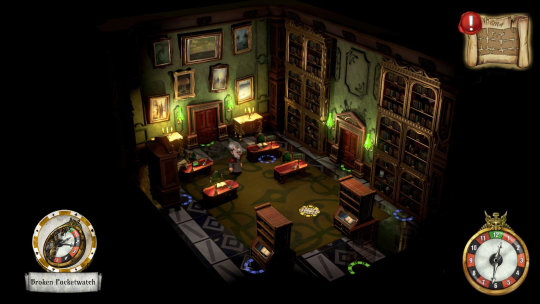
One of 2017’s most unique games: The Sexy Brutale is a Groundhog Day-esque murder mystery adventure. Stuck in an infinite time loop, the player needs to witness party-goers at a mansion party get killed throughout the night. Using the knowledge you’ve received as well as the ability to reset time by a few hours, you’re able to foil the attempts at their lives and slowly piece together the story and motives. This isometric puzzler presents you with a simple objective but continues to use it in clever ways throughout the story to fill in all of the missing pieces in this adventure. Figuring out how to save each character is a joy, and the setting and soundtrack help make this something that won’t soon be forgotten.
8. Horizon: Zero Dawn (Guerrilla Games - PS4)

After over a decade of developing Killzone games, Guerilla Games delivered a fresh and intriguing new world with Horizon. In the developer’s self-described “post-post-apocalypse”, you’re given a beautiful open world filled with the remnants of civilization that went nearly extinct thousands of years prior. Horizon does a good job painting a picture of new class structures and struggles as humans redevelop their societies, but the true spectacle comes within slowly learning more about what caused the downfall of humanity in the first place. It’s a well-told tale that helps sets the table for more adventures to come in this universe in the future. Combat and discovering the weaknesses of beasts in battle is a great hook, and the strong gameplay gives you reasons to stick with Aloy for dozens of hours.
7. Pyre (Supergiant Games - PC, PS4)
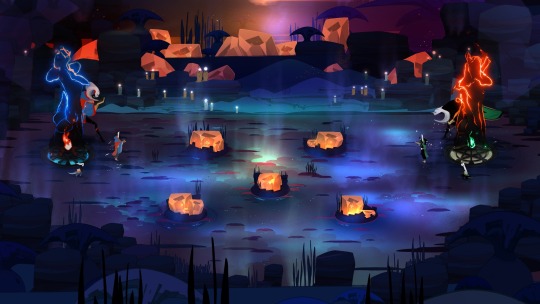
With its third entry, Supergiant created another enthralling universe to get lose within. Pyre’s gameplay hook of “RPG meets NBA Jam” is a great way to get people into the door, but what’s more important here is the story that is told. Half the game presents itself as a visual novel of sorts, where you spend time talking to various members of your party (as well as your opponents) to build a bigger sense of what being trapped in this underground is truly like. Winning your matches is important, but if you lose, the game continues, as your loss hindered the team and is part of the story. There are no do-overs in this world, and you must soldier on even if your failure caused members of your team their freedom. This is one of the strongest aspects of the game, and the relationships you build with the multiple well developed characters in this game make you want to earn their freedom, even if it means you lose them for future matches. The battles are fun every time, but the true reason to stick around this world is the characters.
6. Wolfenstein II: The New Colossus (Machine Games - PC, PS4, XBO)
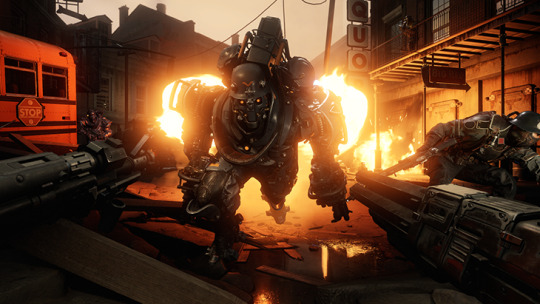
Wolfenstein II is probably the game that features the worst gameplay on this list. Why mention that and even put it on this list? Well, that’s because tearing through this world and seeing the adventures of B.J. Blazkowicz and his resistance team is a sight to behold. Set in an alternate reality a few decades after the Nazis won World War II, there isn’t much hope left in the world for those fighting back, and this is a story about starting a revolutions. Words cannot even describe the twists and turns this story takes, as there are enough clever moments and setpieces that could fill a whole series instead of just a single game. I found myself putting down the controller several times out of shock with a “did they really just do that?” thought throughout the adventure. It’s quite alright to throw the settings to easy and tear through this adventure, as it isn’t something to be missed.
5. Cuphead (StudioMDHR - PC, XBO)
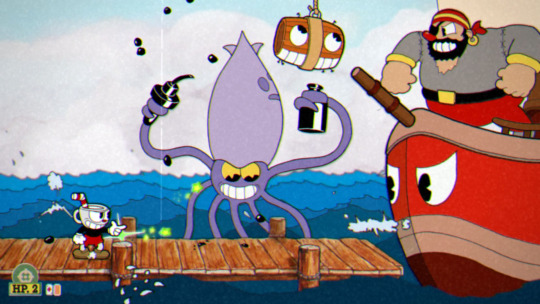
There’s one thing painfully obvious about Cuphead right off the bat: this 1930s cartoon inspired run-and-gun platformer is one of the most beautiful games you’ll see in motion. The game is so faithful to its source material, straight down to the occasional tears in the film and garbled voice audio from some characters. StudioMDHR went for an aesthetic, and they nailed it. However, looks aren’t what make a game, and Cuphead’s true strength comes within its stellar gameplay and boss design. It feels like you are playing a modern-day Gunstar Heroes while you tear through dragons, genies, haunted roller coasters, and so many more diverse villains. While everything may look cute, this game provides a challenge that is not for the weak of heart, but it’s certainly worth surmounting. The boss battles a true delight, and something as simple as a progress meter that shows how far you got during your failed attempt is a great touch to make you want to immediately hop back in to try to redeem your loss.
4. Super Mario Odyssey (Nintendo EPD - Switch)

While Super Mario Galaxy 2 may be my favorite 3D Mario, there’s something to be said about Nintendo wanting to go back to the world-exploring approach seen in Super Mario 64. What resulted is a fantastic journey through a dozen worlds with clever platforming and environments that reward you for searching every nook and cranny. Almost every level brings fresh ideas and challenges that help present one of the most fun Mario adventures yet. All of that being said, I haven’t even touched on the capture mechanic, which helped breath new life into this story. Using Mario’s new hat companion, Cappy, you are able to possess a majority of enemies you come across to gain their abilities. The foes you can overtake range from classics like Bullet Bills and Chain Chomps to new foes such as a giant T-Rex. These traits help you look at your surroundings like you couldn’t before and uncover new secrets and objectives, leading to an absolute sense of wonder for the player. From the New Donk City Festival to the Darker Side, the moments in this game will keep a smile on your face throughout.
3. NieR: Automata (Platinum Games - PC, PS4)
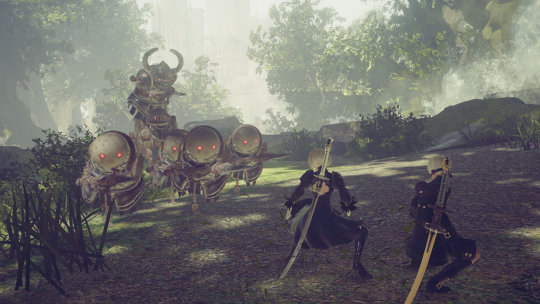
NieR took me a very long time to finally get through, as there were a few separate occasions early on where I fell off the game. I decided to stick with it, and shortly after I came to a moment that I immediately intrigued me to keep pushing. After finishing the game (aka Route A), I enjoyed it enough to see what the alternative routes would show me. Immediately upon starting the second playthrough, I was hooked and the game wouldn’t let go until I saw the credits no less than six more times. The twists and turns the story takes in NieR are unprecedented, and the beauty of is it in the way that the story itself is told. This is one of those experiences that wouldn’t have the same effect if shown in another type of medium. The answers are in front of you the whole time, but seeing the way that the game handles subjects such as loyalty, the human essence, and society as a whole are fascinating. Characters are built so incredibly strong in this world that you want to see what happens to each one of them, even if the outcome isn’t usually the happiest. It’s to the point where even the end credits have a moment that left me with a “wow, I can’t believe they did that” feeling. It’s a hard game to discuss without spoiling some of the genius found within, so if you’re at all interested, it’s worth a look. It’s been weeks since I’ve finished NieR, and I still can’t stop thinking about some of its themes and story.
2. The Legend of Zelda: Breath of the Wild (Nintendo EPD - Switch, Wii U)

The crown jewel of Nintendo’s new platform is Link’s latest adventure. It’s hard to think of an open-world created that is as stunning and provides the freedom to explore as the world found here. 2013’s handheld Zelda, A Link Between Worlds, toyed around with the idea of giving the player access to most abilities immediately and setting them loose in the world. Breath of the Wild took that concept and ran with it, as you spent the first few hours on a seperate plateau learning the mechanics and receiving all of the items that give Link his abilities in the game. Once you have that, you’re turned free to go anywhere you want in the world. I spent dozens of hours just exploring mountains, lakes, and deserts before even approaching the first story milestone of the game, as there was just so much to do by wandering. Something as simple as giving Link the ability to climb instead of gating with invisible terrain presents the player with the ability to explore so much so quickly, and the world seems so vast thanks to it.
Nintendo’s decisions to add challenge shrines, which were all mostly unique, in place of the typical heart piece search granted a new reason to try to uncover everything there was in the world. The in-game physics also lead to so many moments of creating unique solutions to obstacles and combat that you won’t believe what you can pull off. The newest Zelda also used one of the series core strengths, its music, in a novel way, as the world is more silent and songs are used more as ambiance to accompany Link in key moments, and it works. It’s a world you’ll never want to leave, and the fact that Nintendo provided a Zelda adventure that can give you 100 hours a playtime if you choose is something truly special. The one piece that was the deciding factor of keeping Breath of the Wild out of my top spot was the dungeons, as the focus on letting the player have access to all abilities led to all the dungeons and their bosses seemed sub-par compared to everything else. Still, this is not an experience to be missed.
1. PlayerUnknown’s Battlegrounds (PUBG Corporation - PC, XBO)
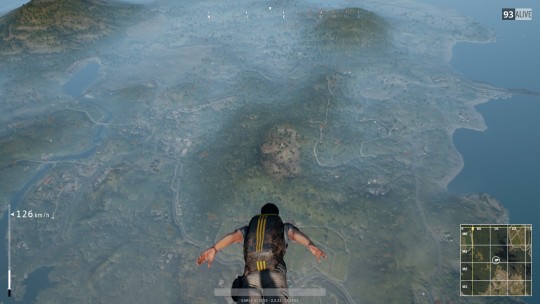
As with most people, if you would have told me I would have been hooked by a full game version of one of those Battle Royale mods in 2017, I would have called you crazy. However, here we are. Very early in the year, I found myself watching a few PUBG streams on Twitch and decided to pick it up about two weeks after it launched in Early Access. I mentioned at the start of this list how I consistently played TypeShift throughout the year, but 2017 was also the year that I was constantly drawn back into PUBG week after week.
The concept is simple: you and 99 other people are dropped onto an island with nothing. The goal: be the last person standing. This isn’t the first time this has been attempted, as I mentioned earlier how mods and other games have attempted this same idea. However, this is the first time where it’s been streamlined in a way that makes it super easy to hop in and play. There’s nothing overly complicated about it: as all you need to do is run around and loot weapons and recovery items to better prepare you for battles you’ll have on a fairly large map. In one of the ways that makes PUBG so accessible, there’s always a circle slowly encroaching onto players to ensure games move quickly and that you cannot just hide in one spot. Sure, you can hide in a bathtub and hope to get lucky with circle positioning, but it’s probably not going to happen.
No two games of PUBG are exactly alike, and there’s nothing that compares the heart-pounding experience of being one of the last 10 people alive, knowing your next move could win you the game or expose you to be easily killed by another opponent. It’s a game that has already inspired developers to start working on adding similar concepts to their games, and this could very well be looked back at as a seminal title years down the line. It’s been a fantastic year for video games, but nothing could compete with the thrill of trying to earn a chicken dinner in PUBG in 2017.
0 notes
Text
The Turing Test (2016) Review
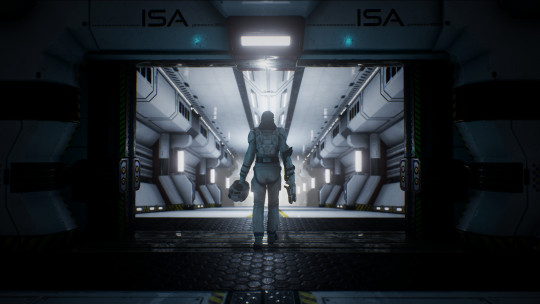
The Turing Test is a first person puzzle adventure game where you play as Ava Turing (heh heh get it? Turing test?), an engineer who has been sent to a base on Europa, one of Jupiter’s moon, to discover the reason behind the sudden disappearance of the ground crew there. When you arrive, however, you find that the crew has converted a set of rooms into puzzles that only a human could solve, as to keep robots out (theoretically, I’ll get to that in a bit).
This review is going to avoid blatant spoilers of anything major.

Gameplay
As aformentioned, The Turing Test is a first person puzzle game. I probably will draw a lot of similarities to games like Portal and other games in the same genre. Anyway, the main way you interact with puzzles is with your ‘Energy Manipulation Tool’ (their quotes not mine), which is essentially just a gun that allows you to sudck up power core thingies which act as batteries to power elements of the environment. You can only hold three at once and you can’t change the order they’re stacked in, so in other words if you suck up a new core, you’ll need to stick that core somewhere before you can use the other cores you’ve previously sucked up. On paper, this sounds pretty well and good, and even in the game for the most part it’s a pretty intriguing concept. There are different types of cores that you can find, some of them alternate on and off, some are only on for a short while after they’ve been placed, and it works well. Usually the puzzles are a matter of getting what is effectively a door open so that you can get through to the next puzzle, with there being 70 puzzles in total and 7 extra optional puzzles. I have some issues with the puzzles. By the end of the game, puzzles start to end up feeling like a chore. The puzzles don’t become challenging to get through like near the end of the Portal games, instead they just have so many bits tacked on that you have to take a minute or two to actually figure out what the hell is going on. And the inability to change which orb you fire out quickly becomes obsolete as you can always expect there to be three power sources for you to sort things out with. The middle of the game is where the puzzles really peak, and even then they’re not super difficult, just kinda clever. There are a lot of times where I felt like I wasn’t supposed to solve the puzzle how I did. Like how Portal speed runners sometimes do little tricks where they shoot a portal at just the right angle at just the right time so it goes through a tiny little gap and hits a wall right at the end of a puzzle. Except that seemed like the main way to solve some puzzles near the end of the game. Nevertheless, the puzzles are worthwhile, and you’ll have fun with them. The puzzles are the game’s strong point, and honestly if you just want a first person puzzle game for the intent of doing nothing but playing through puzzles, you can basically stop reading now because you’ll probably like it. It only took about 5 hours to 100% it for me, but I don’t feel like I wasted any of those five hours.
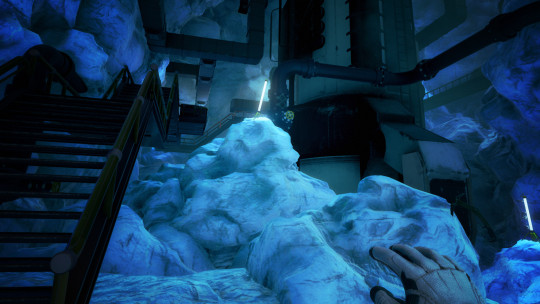
Performance and visuals
This game is made on Unreal Engine 4. As you can imagine, it looks pretty excellent, albeit most of the game does take place in sterile test chambers. Except occasionally there’s a little section in some ice, or sometimes you’re in a laboratory with lots of props and the like, and visually it really shines in those areas. And it runs great too, although the graphics menu has some questionable choices. For instance, it has these lens flares that go over a chunk of your view sometimes which I’m absolutely fine with personally, but I know that there are people who would hate them. The issue is that you can’t just disable them. You’d need to lose them along with bloom and that brightness adjustment thing where everything gets darker if you’re looking at something bright all at once. It’s only a minor thing, but it’s not that hard to put some check boxes in your menus. Everything is on a slider from Low up to Ultra, and while there’s a lot you can modify, I’d still like to be able to manually choose specifically what I enable.
Overall it’s pretty well optimised for PC.

Story
This is where everything goes to shit. The story at the start stays intact, but as you go it tries to be more and more clever, then starts being pretentious, and then everything bursts open. At the start, you’re flown onto the moon base and you go inside and “Woah!” you say “It looks like they’ve transformed the base into a series of puzzles!”. Or at least you would if it weren’t that the base’s AI, T.O.M. hadn’t of already said it. Lots of puzzle games have a robot that tells you stuff, except generally they either start off knowing as little as you do (think Weatley from Portal 2), or they start off knowing everything except they don’t have a real relationship with the player character so they don’t tell you anything (think GLaDOS from the original Portal). T.O.M is a weird mix between the two, and it just doesn’t work as well. Anyway, so T.O.M explains that he thinks the puzzles are some sort of Turing Test type thing to keep any robots and AI out, and explains that they’re too lateral for an AI to handle. That’s hilarious, considering AI would be much quicker to solve that type of test if anything. Now you’ve got that little hole in the story which is questionable, but really they didn’t do too terrible of a job explaining why there are so many puzzles on a space base for some reason. The issue comes up later, when this whole robots-can’t-do-puzzles thing contradicts itself when the writers start trying to be more clever than they actually are.
But then you get to the optional puzzles. These simply aren’t likely to ever exist in a situation like this, but for some reason, the people who built the puzzles thought “Hey, why don’t we put some audio logs behind more difficult puzzles for no apparent reason?”. It seems fine on the surface, seeing as though they wanted to include some story bits that you need to work for. Except then you go back to Portal, and remember that there’s a whole subplot you could skip hidden around the puzzles. Granted, these are a slightly different concept; they’re less direct story telling moments, but my point stands that it makes more sense in Portal.
You can ignore that, but then you’ll find that every 10th room, the people who built the puzzles thought “Hey, why don’t we keep a small section of the base with all our stuff still in it, and always put it at exactly every 10th puzzle?”. It just makes no sense, if the base was actually still being used after they built the puzzles, you’d need to go through 60 puzzles every single time you wanted to cross the god damn base! But the last 20 you probably won’t be doing, because they literally make zero sense if you think about it. To put it spoiler free, you need to start taking advantage of robots and AI to get through a set of puzzles designed to keep robots and AI out.
And then the game starts asking that you show some emotion for the characters near the end, even though they’re all mentally retarded. They want you to think that the robot is mean and heartless and other bad things, but really he’s the only one thinking logically out of all of them. So when the inevitable moral choice comes around, it’s not at all warranted, and you don’t feel like you’re actually doing anything. It seems that every time this game throws another interesting concept into the mix, it breaks everything else and weakens the story.
Overall, the story tries some interesting things, but constantly fails to execute them all that well.
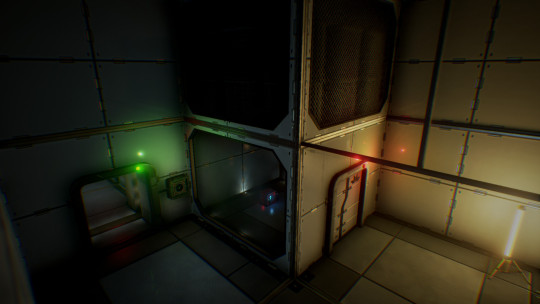
Music and Sound Design
Eh, it’s alright. Nothing amazing, but it’s alright. The music is pretty good, but it’s not the sort of music you’d listen to outside the context of the game. A majority of the music is classical style piano based stuff, usually with the same melody which changes slightly to reflect the mood of the story. The sound is alright, but sometimes it feels slightly off to what’s happening on screen. Voice acting isn’t bad either. Nothing is bad in this department, but nothing is really anything more than average. Not bad, just not amazing.

Steam Controller Support
For this review onward I’ll do a grade system for this bit, just so I don’t waste your time.
Grade: A
Simultaneous mouse and keyboard works fine, although there are as always some issues with changing button prompts. Overall though, basically flawless in this area. Works best with either a mouse and keyboard or Steam Controller, entirely up to you.
Tidbits
Price to length
As I mentioned earlier, this game took me about 5 hours to 100%. It costs $19.99 on Steam. That’s just too much, especially when you consider that there’s almost no replay value. They needed something like the challenge maps in Portal, or a time trial mode, or just anything to give it a bit more content and replay value. I’d pick it up for $10 or less, preferably around $5. There are some games, like The Witness, which deserve this price point, but The Witness actually has $20 worth of content.

The Verdict
Gameplay - 8/10
Visuals - 8/10
Performance - 7/10
Story - 2/10
Music & sound - 5/10
Tidbits (incl. SC support) - (-0.5)
Score out of 50 = 8 + 8 + 7 + 2 + 5 - 0.5= 30.5/50
Final score =
62%
(Above averaqe)
(6/10)
A great puzzle game which has its head up its own ass when the story sections come around.
TL;DR: Definitely consider this game, but don’t expect a great story, and wait for a sale.
0 notes